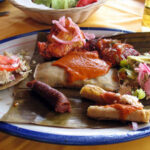*Instructions:
Your job is to complete the attached medieval menu for a king and peasant. Each menu must include the following:
1) Dairy Product
2) Meat
3) Vegetable
4) Dessert
5) Bread
After you complete your research of food during the medieval period and your menu do not forget to explain how the foods you chose reflect medieval society and culture.
*For a King:
A fine meal of roasted salmon, marinated in garlic, and the cooks other choice seasonings, with a side of lovage (a leafy green plant) dressed in oil and vinegar. Along with this grand meal there will be a hefty loaf of manchet (white) bread. There will be a wide selection of wine to choose from. For desert, a variety of fruit pies, sweetened with honey.
Why this meal? – Some might ask why I didn’t add a dairy to this cuisine. Back in these times nobles did not partake of much dairy, because they thought it was unfit for their table, and only appropriate for the lower class. Salmon was very popular for the nobles. A website suggested lovage for a meal at the table of nobles, and that is a leafy green plant that has a taste similar to celery. The nobles ate white bread, because it was more expensive. Nobles didn’t eat many vegetables or fruits, and what they did eat was baked into pies. They drank wine, which was not asked of in the directions, but what it a meal without drink?
*For a Peasant:
Tonight in this humble abode, we will have roasted lamb, hot from the spit, with crumbled cheese, along with a side of cabbage. To go along with our course is a loaf of barley bread, also still warm from the oven. For a special treat, tonight we will be having a fruit mixture with nuts and honey.
Why this meal? – Peasants actually had more of a well balanced diet than the nobles (go figure!). They ate what the nobles turned down, and what was more available to them. Most of the time the meat was not seasoned, so they would roast it to give more flavor. Unlike the nobles, peasants partook of dairy. The peasants ate barley bread because it was cheaper than white bread. It was rare for peasants to have desert, but when they did it was fruit, and for an extra special treat they would sweeten it with honey.
*Fun Facts:
- The Church frowned on late suppers, because they claimed they made men gluttonous.
- People of this time (rich and poor alike, more common in the rich) did not have a good balanced diet. The nobles are very few fresh vegetables and fruit, because it was viewed with a certain suspicion.
- Vegetables which came from the ground were only considered fit to feed to the poor.
- Dairy products were deemed as “inferior foods” and were only eaten by the poor
- Upper classed foods were highly spiced. Spices such as: Pepper, cinnamon, Cloves, Nutmeg, Ginger, Saffron, Cumin, Garlic, and Mustard, were used daily to prepare meals for them.
- Believe it or not most meals the nobles ate were cold, and most parts of the peasant’s meals were warm. This is because the nobles ate so far from the kitchens, whereas the peasants ate in the kitchen.
*Sources:
http://www.middle-ages.org.uk/middle-ages-food-and-diet.htm



